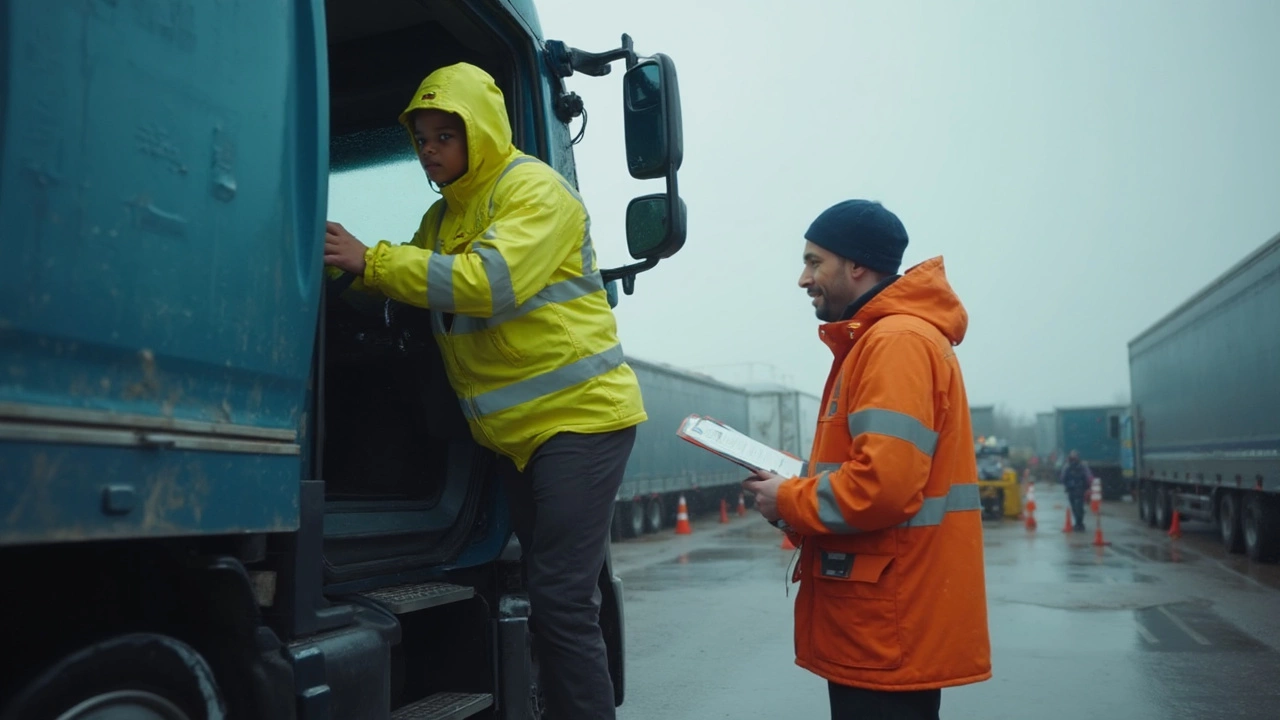Wondering what HGV training actually involves? You’re not alone—loads of people have no clue until they turn up for day one. It's not just about hopping behind the wheel of a massive lorry. There's a set process, and it’s stricter than you might think.
Before you ever touch a steering wheel, you’ll be dealing with paperwork and theory. This means getting a provisional HGV licence, passing a medical, and digging into the Highway Code—yeah, stuff you might not have looked at since learning to drive a car. The rules are different for heavy vehicles, so you’ll need to know them inside out.
But here’s something most folks miss: you don’t just learn to drive the truck. You’ll cover safe loading, vehicle checks, and even what to do if you break down on the side of the road at 3 a.m. There’s a load of practical stuff to take on board—literally and figuratively. If you skip steps early on, it’ll bite you later, especially on the tests.
- First Steps: Theory and Requirements
- Getting Behind the Wheel
- Test Day: What Really Happens
- Insider Tips for Success
First Steps: Theory and Requirements
Getting started with HGV training isn’t as simple as turning up, grabbing the keys, and driving off. Before you even see the inside of a lorry, there are a few non-negotiables you’ve got to handle.
First, you need to be at least 18 years old and already hold a full car licence (Category B). After that, medical checks are up next. You’ll need a doctor to fill in a DVLA D4 medical form to prove you’re fit enough for truck driving. It isn’t just checking your eyesight—they’ll look for things like blood pressure issues or anything that could mess with your reactions on the road.
Provisional entitlement is the next box to tick. This is basically the learner’s permit for lorry drivers, officially called a Category C or C+E provisional licence. Getting this means filling out the D2 form and sending it off to the DVLA, usually with your D4 medical.
Now comes the theory part—definitely not something to ignore. You’ll be prepping for two tests: the HGV Multiple Choice Theory Test and the Hazard Perception Test. Loads of people trip up here because the questions cover things you don’t get with ordinary car tests. For example, you’ll need to know about load security, tachograph rules, daily walkaround checks, and working time regulations. And yeah, you really do have to know it all—because it’ll come up again later.
- HGV Multiple Choice Theory Test: 100 questions, pass mark is 85/100.
- HGV Hazard Perception Test: 19 videos, pass mark is 67/100.
If you want to see how tough the tests are, check out this quick breakdown:
| Test Name | Questions/Videos | Pass Mark |
|---|---|---|
| Multiple Choice Theory | 100 questions | 85/100 |
| Hazard Perception | 19 videos | 67/100 |
Don’t skip studying—over 35% of first-timers fail at least one of these. Apps and mock exams are a lifesaver. Pass these, and only then will you move on to the hands-on stuff.
Getting Behind the Wheel
This is when HGV training gets real: you’re finally in the cab of a truck. Most people get a bit nervous at first—the size difference from a car is no joke. Your first few hours will cover the basics like steering, gear changes, and how far that rear end actually swings out when you turn. You’ll learn in a dual-control lorry, so your instructor can step in if things get hairy.
According to the UK’s Driver and Vehicle Standards Agency, the average course spends about 20 hours on the road before even thinking about the practical test. So don’t stress if you stall in the yard; it’s part of the process. Here’s what your hands-on HGV training usually covers:
- Basic controls—gears, brakes, clutch (and yes, they're heavier than your family hatchback).
- Vehicle checks every time you start out—you're expected to spot faults before hitting the road.
- How to reverse a vehicle that’s longer than a bus without taking out a fence. It’s tricky at first but totally doable with practice.
- Proper mirror use—you’ll become obsessed with blind spots, especially on city streets.
- Safe loading—balancing cargo so you’re not thrown around on bends.
One stat that surprises most trainees: when reversing, it takes the average rookie eight minutes to park an HGV correctly on their first try. With practice, you’ll get that time down, but don’t expect perfection straight away.
Your instructor’s job is to hammer home safety. According to Paul Maidment, an approved HGV instructor,
"We train drivers to anticipate mistakes before they happen—HGVs don’t forgive second chances."So it’s less about speed and more about getting things right.
Throughout your driver training, you’ll swap between classroom briefings and the yard. You’ll learn to handle both urban traffic and open motorway stretches, plus tricky spots like roundabouts and busy junctions. It’s intense, and your confidence will wobble, but that’s normal. Every pro started nervous too.

Test Day: What Really Happens
Test day for HGV training feels a bit like taking your driving test all over again, just bigger and with more nerves. The UK test is split into two main parts: the practical driving test and the 'show me, tell me' questions (officially called the practical demonstration test).
The practical driving test usually kicks off with safety questions right there in the test centre car park. The examiner could ask you about daily walkaround checks—tyres, lights, reflectors, fluids, load security. Get these nailed in your prep: missing a simple detail can cost you marks before you even start the engine.
- Show Me: You’ll be asked to demonstrate a vehicle safety check, like showing how to check oil or operate the tachograph.
- Tell Me: These are questions about what you’d do in certain situations, like what checks to do before a long trip or how to spot a defect with the brakes.
Next is the real driving bit. The route will cover different roads—towns, country lanes, dual carriageways. The examiner is checking not just your ability to control the lorry, but how you read the road, spot hazards early, and keep cool under pressure. You’ll be expected to:
- Handle roundabouts and junctions smoothly
- Reverse into a defined bay, using mirrors and markers
- Demonstrate proper use of gears and brakes, especially on hills
- Keep a safe distance from other vehicles and observe speed limits
Here’s something that surprises a lot of new drivers: you need to drive with fuel efficiency and comfort in mind, not just technical skill. Slamming on brakes or heavy acceleration can dock you points.
Around 46% of candidates pass their HGV test first time, according to DVSA stats from last year. Get used to the idea that it might take two tries—it’s not rare. Markers or cones often trip people up on reversing, so practice that until it’s second nature.
After the drive, the examiner tells you straight away if you’ve passed. If you do, you’ll get your pass certificate and can start sorting out your full licence. If not, you’ll get feedback and can book a retake, usually pretty quick.
| HGV Test Facts (UK) | Details |
|---|---|
| Average First-Time Pass Rate | 46% |
| Test Length | Around 1.5 hours |
| Main Fails | Observation, Mirrors, Gears, Reversing |
| Show Me / Tell Me Questions | Up to 5 each |
Bottom line: turn up rested, confident, and ready to show you know your stuff—not just drive but handle everything an actual job throws at you. That’s what gets you through the finish line.
Insider Tips for Success
Want to ace your HGV training and actually pass those nerve-wracking tests? There are a few things old hands wish they’d known right from the start. It isn't just about being a steady driver — it's about knowing what the examiners are really looking for and how to handle the unexpected.
First, go over the basics until they’re second nature. Examiners have seen it all, and they’ll spot if you fumble through routine checks or faff about with gears. Reliable sources like the DVSA stress the importance of foundation skills, saying:
“Preparation is everything – drivers who put in the time practising the basics tend to breeze through the practical and theory parts.”
One solid hack: practice your vehicle checks out loud, as if you’re explaining them to someone else. It sounds a bit daft but it cements the process in your head. Get used to the walkaround test; it’s a big cause for minor fails and you don’t want to lose marks on something you can master in your sleep.
Also, make your practice as close to real-life as possible. Don’t just stick to empty car parks or the same quiet stretch of road. Find busier spots, deal with awkward junctions, and get a feel for tight reversing on actual test routes if you can. According to 2024 DVSA data, most fails happen due to poor judgement at junctions and lack of proper mirror checks. That’s an easy place to score points if you’re disciplined.
| Common HGV Test Fails | How to Dodge Them |
|---|---|
| Poor mirror use | Check frequently and exaggerate your checks in view of the examiner |
| Struggling with vehicle checks | Repeat them regularly, out loud and by heart |
| Poor judgement at junctions | Practice in busy areas at different times of day |
Don’t ignore your nerves. If you’re stressed, you won’t perform. Arrive early, breathe deeply, and focus only on what’s in front of you—not your mistakes or the examiner’s clipboard. Loads of successful driver training students say chatting with other learners in the waiting area took the edge off test-day nerves.
Finally, never be afraid to ask questions, even if you feel a bit silly. Trainers don’t expect you to know everything. In fact, asking about something you find tricky usually makes them pay more attention to your weak spots, which ups your chances on test day.

